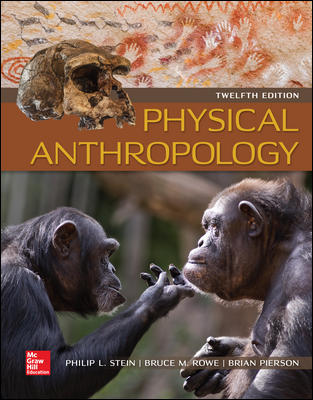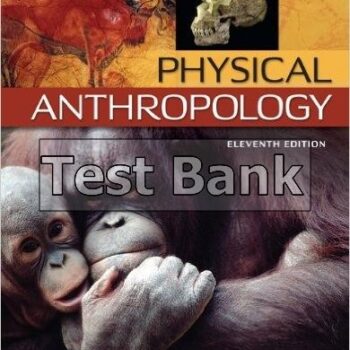
Test Bank For Physical Anthropology 12th Edition by Philip Stein
Original price was: $55.00.$35.00Current price is: $35.00.
Digital item No Waiting Time Instant DownloadISBN10: 1259920402 ISBN13: 9781259920400
Are you ready to pass your Physical Anthropology tests with high marks? The Test Bank for Physical Anthropology 12th Edition by Philip Stein is a useful material that is helpful for effective preparation. Be it a student trying to improve his results or an instructor hunting for good questions to use during his quizzes and exams, this test bank is all that you need.
What Does The Test Bank for Physical Anthropology Contain?
The Test Bank for Physical Anthropology comprises exam questions formulated to encompass the core issues discussed in the textbook authored by Philip Stein. This package includes MCQs, SAQs, and T/F items thus allowing you to test your knowledge using different styles. This test bank is aimed at enhancing your grasp of human evolution, human genetics, primatology, archaeology, and other intricate topics.
Why Should You Use The Test Bank For Physical Anthropology 12th Edition?
- Comprehensive Coverage: The test bank consists of unit questions that are centered on all of the Physical Anthropology 12th Edition chapters and hence you can assess every single aspect that you have learned.
- Assists in Completing Coursework: This is very self-explanatory. By answering these questions, you can find out where your proficiency is lacking and try to put your efforts into the particular area.
- Real-World Application: The questions in this particular test bank are in some way related to the physical anthropology field and contain concepts and theories dealt with in the textbook. Moreover, this gives you a better picture of what to expect in your assessments.
- User-Friendly Learning Aids: This test bank can be helpful for students to people who are constantly on the move. It’s a good and effective method of preparing for examinations since the quality of questions and materials is good but there is no need to scour out materials for hours.
How the Test Bank Benefits You
- Success in Examinations: A test bank can help improve your performance by simply using it to take examinations. In essence, it helps you become skilled with the range of questions that you might see in your actual exam thus improving your confidence.
- Saves Time: Instead of drafting your own set of questions for practicing, the practice questions are already available in the test bank. This enables you to concentrate on content and question answering rather than question creation.
- Personalized Study Sessions: The test bank has the functionality that enables you to select particular chapters or topics you want to study. Thus, it makes the selection of topics by your requirements more convenient.
- Evaluation Of Knowledge: You can create an assessment of how many topics you have fully learned and how many more have to be completed.
Good For Students as well as Teachers
If you are a student, the Test Bank for Physical Anthropology 12th Edition can be a critical factor in your study. This could help you in reviewing a certain set of materials that would prove helpful in class.
And for teachers, this test bank is a useful resource in preparing quizzes and tasks that would test students”’ learned concepts of physical anthropology.
Conclusion
To conclude, Test Bank for Physical Anthropology 12th Edition by Philip Stein is the best companion for a person who is studying or teaching this subject. Simply put, it contains all the necessary questions in a logical sequence, includes all major topics, and is well-designed as a revision before exams. Even if you’re looking for human evolution, genetics, or other important topics, this test bank is there for you to get the best understanding and grades.
Test Bank For Physical Anthropology 12th Edition by Philip Stein
Chapter 03
The Modern Study of Human Genetics
Multiple Choice Questions
1. A single nucleotide polymorphism (SNP) refers to A. an error in the genetic code involving the replacement of multiple proteins by a single protein. The presence of only a single allele of a gene. An error in the genetic code involving a single change of a nucleotide at a particular point. The presence of a dominant allele and a recessive allele of a single gene
Accessibility: Keyboard Navigation
2. How many major alleles does the ABO blood-type system have? A. oneB. twoC. three. four. More than four
Accessibility: Keyboard Navigation
3. The hemoglobin molecule is composed of four chains of amino acids: two alpha chains and two beta chains. The start of the code of the beta chain is GTGCACCTGACTCCTGAG. This codes for the first six amino acids of this chain: valine-histidine-leucine-threonine-proline-glutamic acid. If a single nucleotide polymorphism (SNP) occurs in the code for glutamic acid, which of the following will be a consequence of the SNP? A. it will result in a different amino acid replacing glutamic acid. It will result in glutamic acid replacing all six amino acids at the start of the beta chain C. It will result in the amino acids present after glutamic acid in the beta chain being replaced by different amino acids. it will result in glutamic acid replacing all amino acids in the beta chain
Accessibility: Keyboard Navigation
4. Phenylketonuria (PKU) is an inherited: A. skeletal abnormality. Blood disorders. Metabolic abnormality. psychiatric disorder
Accessibility: Keyboard Navigation
5. Ashkenazi Jews: A. are the only population to carry the allele for Tay-Sachs diseaseB. have a high carrier rate for Tay-Sachs diseaseC. have the lowest carrier rate for Tay-Sachs diseaseD. may have a high carrier rate for Tay-Sachs disease but also possess a regulator gene that prevents the disease from expressing itself
Accessibility: Keyboard Navigation
6. Achondroplastic dwarfism in humans is inherited as A. a result of a dominant allele. A lethal recessive C. An X-linked trait. a recessive
Accessibility: Keyboard Navigation
7. Which of the following is a late-onset genetic disease characterized by the loss of motor control associated with jerky movements and psychiatric symptoms? A. Klinefelter syndrome. Turner syndrome. Tay-Sachs diseaseD. Huntington’s disease
Accessibility: Keyboard Navigation
8. Which of the following is true of Huntington’s disease? A. it is a result of excessive GGG repeats. It is a result of excessive CAG repeats. It is inherited in a codominant pattern. it is inherited in a recessive pattern
Accessibility: Keyboard Navigation
9. A Punnett square is a grid used in genetics to A. show the genotypes and their probabilities of a particular gene in a mating. Show the probability of occurrence of the actual phenotypes for a particular gene. Calculate the frequency of a genetic abnormality in a population. calculate the frequency of a particular phenotype in a population
Accessibility: Keyboard Navigation
10. A child is diagnosed with Tay-Sachs disease. Both the father and mother are carriers (heterozygous for the disorder). Using the Punnett square, it can be estimated that the probability of them having a phenotypically normal child is: A. 1/4B. 2/4C. 3/4D. 4/4
Accessibility: Keyboard Navigation
11. A couple has a child who is diagnosed with Tay-Sachs disease. Both the father and mother are carriers (heterozygous for the disorder). Using the Punnett square, it can be estimated that the probability of them having a child with Tay-Sachs disease is: A. 1/4B. 2/4C. 3/4D. 4/4
Accessibility: Keyboard Navigation
12. Deviations from Mendelian genetics include A. polygenic inheritance. Multiple-allele series. pleiotropy. all of these
Accessibility: Keyboard Navigation
13. Which of the following genetic abnormalities shows the symptoms of excessive mucus production, digestive and respiratory failure, and reduced life expectancy? A. achondroplastic dwarfism. beta-thalassemiaC. Cystic fibrosis. Tay-Sachs disease
Accessibility: Keyboard Navigation
14. In the context of deviations from Mendelian genetics, polygenic inheritance refers to A. a specific trait being influenced by more than one gene. Both alleleareng expressed in a heterozygous genotype. Three or more alleles exist for a specific gene. a gene-altering the expression of another gene
Accessibility: Keyboard Navigation
15. In the context of deviations from Mendelian genetics, codominance refers to A. the influence of nongenetic factors on a phenotype. Both alleles beiarepressed in a heterozygous genotype. Three or more alleles exexistor a specific gegenea gene-altering the expression of another gene
Accessibility: Keyboard Navigation





